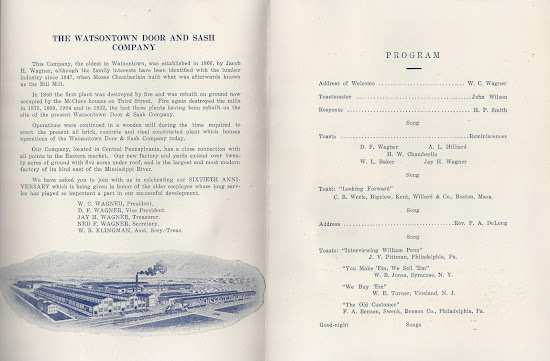
 |
| The Watsontown Door & Sash Company, 1866 - abt. 1934 |
The 1899 Fire
The New 1904 Plant
 |
| Located between 5th & 7th Streets, "East Of The Railroad" (Where Moran Industries is located in 2020) |
The 1922 Fire
March 26th, 1922
The Miltonian reported that so many people rushed to the scene of the fire that cars were in the way of the firemen trying to get to the scene. "the road between the two towns was lined with autoists in a mad rush to to the scene, with little or no concern given the fire department."
 |
| The Watsontown Door & Sash Employees May 1916 |
1929 - Watsontown's Unique Electrical Agreement Begins
1932 - The Company Goes Into Receivership -
Wilson Walkies Are Born
One of the men who was put out of a job when the Watsontown Door & Sash Company went out of business was John Wilson. Finding himself unemployed, he built miniature houses, and toys. His Wilson Walkies are collectible around the world today.
1937 - Property is Purchased by Philco
Find More Of Watsontown's History Here
https://susquehannavalley.blogspot.com/2020/04/watsontown-pa.html
READ MORE
==========
No. 674. January 27, 1933.
Knight Kivko, of Sunbury, Pa., for petitioners.
Frederick V. Follmer and Harry W. Chamberlin, both of Milton, Pa., and John G. Reading, of Williamsport, Pa., for respondent.
JOHNSON, District Judge.
On June 24, 1930, upon application of the complainant, this court appointed receivers in equity of the Watsontown Door Sash Company. Pursuant to an order of this court, the receivers operated the plant for about two years, but, owing to the abnormal industrial conditions, they were unable to continue the operation because of a lack of working capital. On September 21, 1932, the receivers petitioned this court for leave to sell the assets of the company freed and divested from the lien of the mortgage in favor of the Lycoming Trust Company, substituted trustee, for the bondholders, and free and clear of all other liens and incumbrances.
After hearing and argument on the petition of the receivers and answers filed thereto by the trustee under the mortgage and creditors, the court, on December 28, 1932, being of the opinion that a sale free and divested of the lien of the mortgage could not be legally made, entered a decree directing the receivers to sell the property in question at public sale on January 28, 1933, under and subject to the lien of the mortgage.
On January 16, 1933, the Kendall Lumber Company and the W.R. Willett Lumber Company, Inc., creditors of the receivership, filed a petition to vacate the decree of sale on the ground that the decree entered December 28, 1932, was not in conformity with the prayer of the petition of the receivers, in that the petition prayed for a sale of the assets free and clear of incumbrances while the decree ordered a sale under and subject to the mortgage.
There is no merit in the petitioners' contention. Under the broad equity powers of the court, it can, under proper circumstances, order a sale of property free and divested of liens by transferring the liens to the fund derived from the sale; but, where there is no reasonable prospect that a surplus will be left for general creditors, a court of equity will not exercise this power. Seaboard National Bank v. Rogers Milk Products Co. (C.C.A.) 21 F.2d 414. In the present case the property will not bring an amount sufficient to pay the mortgage.
All creditors and parties in interest had notice of the presentation of the petition of the receivers to sell the assets, and an opportunity to file objection and to be heard thereon. The court, in its sound judicial discretion, could have withheld the making of an order of sale or it could have made any order of sale for the best interests of the estate. Stokes v. Williams (C.C.A.) 226 F. 148. The power of the court having control of a receivership to order a sale of the assets thereof by a receiver carries with it the power to prescribe and control the terms and conditions of such sales, and, except as restricted by statute, the court has a wide discretion in so doing. 53 Corpus Juris, 208.
At the hearing on the petition for leave to sell the assets, the court was of the opinion that it could not order a sale of the property free and clear of the mortgage, and therefore, in the proper exercise of its discretion, after a full hearing, the court ordered a sale under and subject to the mortgage, The mere fact that the receivers specified in their petition certain terms and conditions under which the property was to be sold does not take away from the court the power to prescribe other terms and conditions which after hearing are deemed by the court to be for the best interests of the estate.
The petition of the Kendall Lumber Company and the W.R. Willett Lumber Company, Inc., to vacate the order of sale heretofore entered is therefore dismissed, and the rule granted thereon is discharged.

























No comments:
Post a Comment
I'll read the comments and approve them to post as soon as I can! Thanks for stopping by!